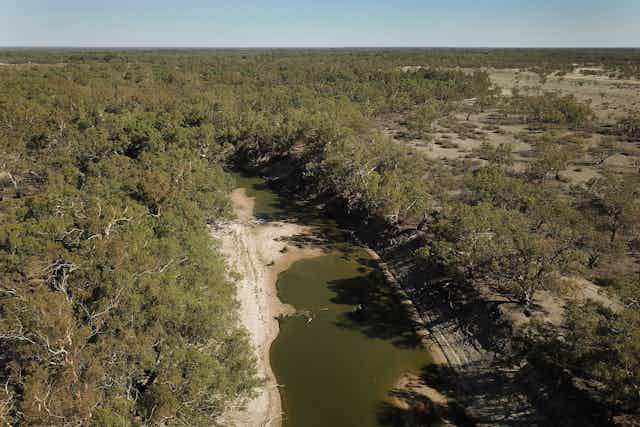The plan to manage water in the Barwon-Darling is not working, according to a draft review released last week.
The New South Wales Natural Resources Commission, which released the draft report, found the Barwon-Darling is an “ecosystem in crisis”. The report provides a robust blueprint for a more sustainable water-sharing plan.
The review confirms criticism the existing plan gives too much water to irrigators and has added to pressures on the entire Murray-Darling ecosystem.
Read more: 5 ways the government can clean up the Murray-Darling Basin Plan
What the plan covers
The draft review examines the 2012 Water Sharing Plan for the Barwon-Darling, which covers 1,600km of the river from Mungindi to Wilcannia. The river here flows south-west through a relatively narrow floodplain with a tightly meandering channel and a highly variable flow pattern.
The river is unregulated and depends heavily on upstream rivers for its water (for example, Condamine–Balonne, Border rivers, Gwydir and Namoi).
January’s massive fish kills around Menindee are only the most recent example of the pressures on the river’s ecosystems. Alongside the fish deaths, research has shown that other aquatic species in the system, such as river mussels, have suffered losses that will take many decades to recover.
Communities that live along the river told the commission people can no longer fish, swim or drink the river water. Graziers struggle to provide water for their stock because the river dries up more often.
Indigenous communities are particularly affected because without water their strong connection to the river – the Barka – is being damaged. A Barkandji elder told the commission:
The river is everything. It’s my life, my culture. You take the water away from us, we’ve got nothing.
Bad priorities
While the review found drought, upstream water extraction in NSW and Queensland and climate change have all contributed to these problems, the greatest effect comes from inappropriate water-sharing rules, particularly when water levels are low.
The law underpinning river management in NSW prioritises protecting the environment and basic landholder rights (including native title) over irrigation. However, the commission found the current plan does not achieve this.
In fact, the plan has been highly controversial since it was enacted in 2012. This in large parts arose because major changes were made between the draft plan circulated in 2011 and the actual plan gazetted in 2012. The commission documents 16 such changes in the review and rates six as substantial.
The NSW government did not publicly explain the reason for such significant alteration in 2012, but there has been much speculation powerful vested interests influenced the government to provide more water for irrigation.
The most important effect of these changes was letting irrigators take water even when the river is very low. The review concludes:
These provisions benefit the economic interests of a few upstream users over the ecological and social needs of the many.
Read more: The Darling River is simply not supposed to dry out, even in drought
What to do?
The review recommends the NSW government urgently change water-sharing rules so these better comply with the legal requirements to protect the environment and other water users, restore community trust and make the river more resilient to future shocks.
Key priorities for the NSW government are:
redesigning the water-sharing rules so environmental protection and basic landholder rights cannot be harmed by lesser priorities such as irrigation
introduce new flow targets to more effectively protect critical ecosystems and enhance river health
change rules relating to water extractions by A Class licence holders during critical low-flow periods, particularly those relating to commence-to-pump, cease-to-pump, and the size of pumps.
introduce and enforce more effective metering and monitoring
develop strategies and rules that address the inevitable impacts of climate change
develop and implement more integrated management of water resources in the northern Murray-Darling Basin.
The commission did note there have been positive changes to the NSW government’s approach to water policy and management since the ABC 4 Corners report Pumped in 2017 and the subsequent Ken Matthews report.
However, the Murray-Darling Basin Plan required NSW to complete a new water resource plan for the Barwon-Darling River by June 2019. The state missed this deadline. The NSW water minister has requested an extension to December 31 2019. A recent assessment by the Murray-Darling Basin Authority suggests NSW is still some way from completing this water resource plan.
Read more: Drought and climate change are driving high water prices in the Murray-Darling Basin
While NSW delays, the Barwon-Darling river system and its communities suffer. The NSW government now has an excellent blueprint for a new plan. It must urgently implement the review’s 29 recommendations and complete a new plan for the Barwon-Darling before the end of 2019.

